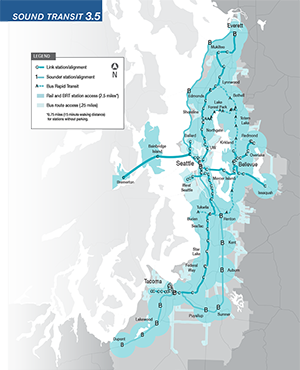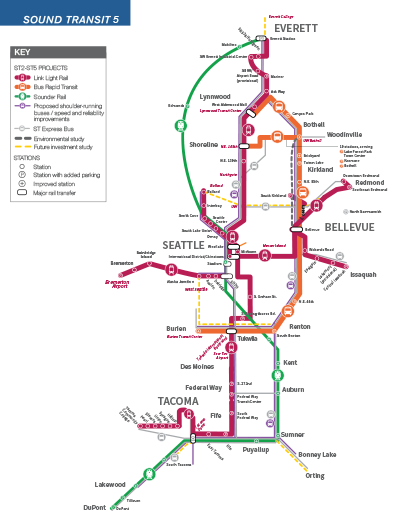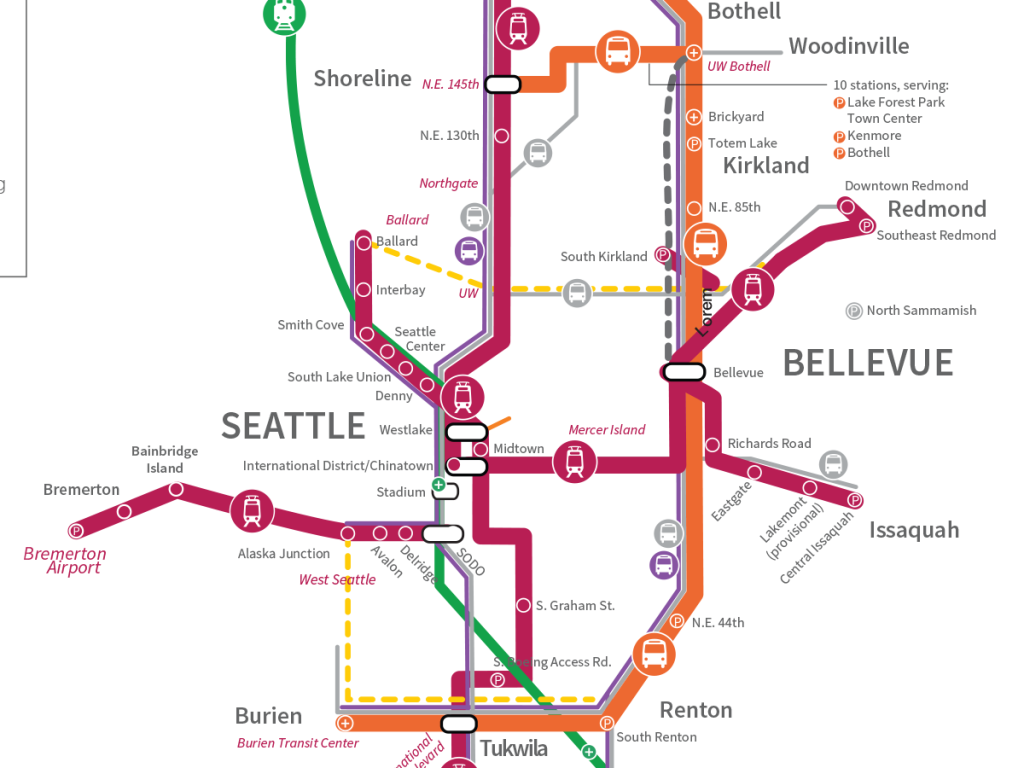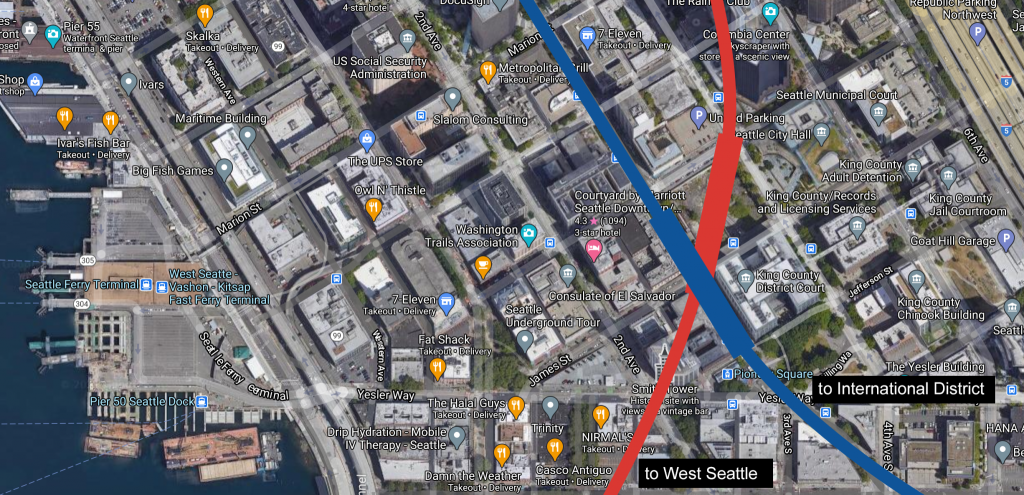Sound Transit 3 will (eventually) see a 21st Century network of light rail connecting the whole of the Seattle Metropolitan Area, from Everett to Tacoma north to south, Ballard to West Seattle within the city, and from out to the foothills of the Cascades west to east.
The one piece of the Metropolitan Area left out of the this network is Kitsap County, and it’s 275,000 (est.) residents, who are connected to Seattle through only through the Bainbridge, Bremerton, and Kingston ferries. Ferries which run just once per hour. Ferries which travel at speeds no faster than the mosquito fleet 100 years ago. Ferries which will all need replacing by the time the whole ST3 lightrail network is complete.

A proposed Sound Transit 5 connects Bainbridge Island and Bremerton to this network through a an under-Sound tunnel carrying the standard Sound Transit lightrail trains. 6.5 miles from West Seattle to Bainbridge Island, 6.3 miles from there to the Bremerton, and then onward to a new Bremerton International Airport.
The two city train stations would be adjacent to the existing ferry terminals, connecting Sound Transit to the existing Kitsap Transit bus network, allowing most of the population of Kitsap County to reach Seattle and the rest of the Metropolitan Area in under half the time required today with a ferry.
Unlike the ferry, the trains could run every 15, 20, or 30 minutes, making commuting far more convenient for the thousands of Kitsap residents who work in King, Snohomish, and Pierce counties.
The challenge of this extension is, of course, Puget Sound. The water is over 600 feet deep in the middle of the channel, necessitating a very deep bore tunnel. Rail runnels at this depth with greater lengths have been built in Japan, connecting those islands with full-size, high-speed trains. Similar tunnels for both rail and automobiles have been built in Denmark. Over 100 years ago a pair train tunnels were built in New York City which are still in use today. In short, no new technologies need to be invented to implement this plan.

This plan adds three stations to the existing, approved ST3 plan, the first two similar in size, scope, and projected passengers as the South Kirkland – Issaquah Link (see the ST3 page for details), and the third eventually carrying a similar number of passengers as SeaTac Airport Station.
Total cost, timing, and other details are TBD. Kitsap County is not part of Sound Transit today, and as such its residents have never voted for nor pay taxes for any of the Sound Transit projects. If this plan is to go forward, at least parts of Kitsap County would need to be added to the Sound Transit taxing district, if not the whole county, and the residents would need to approve this project as the residents of King, Snohomish, and Pierce approved ST3.
Boring a tunnel under Puget Sound will no doubt be expensive, but not as expensive as building a new international airport. The Washington Department of Transportation is projecting growth in airplane boardings in the Seattle Metropolitan Area that will require building new capacity greater than today’s SeaTac Airport. The only two existing airports in the region capable of such growth are Bremerton National and Arlington Municipal (see Airport). When either (or both) of these airports are built to handle tens of millions of boardings per year, they will need connections to the metropolitan mass transit system.
Meanwhile, the Washington State Ferries 2040 Long Term Plan expects to replace all but three of the Central Puget Sound ferries at a total cost of $14.6 billion. Two of the three ferries needing next replacement after 2040 are the two serving Bainbridge Island, and those replacements will cost at least another $1 billion.
Thus despite the multi-billion dollar cost of tunneling under Puget Sound, it may save money in the long run in cost savings of building one new airport instead of two and in replacing the current ferries with smaller boats.
That, and this proposed extension could be the answer on how lightrail can best reach West Seattle.
West Seattle
The continued debate in ST3 is whether to build the West Seattle line above ground or in a tunnel. The residents want a tunnel, but the existing plan and budget is above ground.

The proposed ST5 extension to Kitsap County is best connected to the Sound Transit system in West Seattle. Puget Sound is not at deep between Alki Point and Bainbridge Island as it is between Smith Cove and Bainbridge Island.
If ST3 were to add the proposed Kitsap Extension now, before finalizing the West Seattle line, then not only would there be a new, compelling reason for the West Seattle connection to be underground, but as long as a tunnel boring machine is needed to cross the Sound, that tunnel could connect downtown Seattle to Delridge directly, without the need of a new bridge across the Duamish and without the need for the line to connect to Sodo and Stadium Stations.

In fact, with a deep bore tunnel West Seattle / Delridge could be greatly shortened, popping up in Seattle in the empty hole in downtown Seattle adjacent to the existing Pioneer Square station (see above).
Moving the interconnect from the International District to Pioneer Square would alleviate alleviate the need to disrupt the International District businesses for years, all while putting a tunnel boring machine in downtown Seattle to dig the second downtown tunnel for the line that connects to South Lake Union, Seattle Center, and Ballard.
The fate of that second tunnel is unclear here due to the drop in ridership and loss of funding caused by the pandemic.
Rather than finding corners to cut and rather than pushing out the completion date for ST3, it’s time to look at all the mass transit infrastructure the metropolitan area will need by 2050 and blending those needs into a better plan than ST3.
Step one for that is adding Kitsap County, turning ST3 into ST5.









